![]()
![]()
![]()
Use LEFT and RIGHT arrow keys to navigate between flashcards;
Use UP and DOWN arrow keys to flip the card;
H to show hint;
A reads text to speech;
72 Cards in this Set
- Front
- Back
|
Embryonal development:
Ventral pancreas develops into ____. |
uncinate process
|
|
|
Embryonal development:
Dorsal pancreas develops into ____. |
superiror head, body and tail of pancreas
|
|
|
In most common variant pancreatic ductal system:
Duct of Wirsung drains what part of the pancreas? |
drains most of the pancreas into major papilla
|
|
|
In most common variant pancreatic ductal system:
Accessory duct of Santorini drains what part of the pancreas? |
part of the head of pancreas
|
|
|
Name some congenital abnormalities of the pancreas. (5)
|
- agenesis: not compatible with life
- hypoplasia: malabsorption of fat (exocrine deficiency) - pancreas divisum: dominant dorsal duct syndrome - annular pancreas - heterotopic pancreas |
|
|
What is this pancreatic disease?
- dorsal pancreas drains into minor papilla - smaller ventral pancreas drains into major papilla |
pancreas divisum
- risk for segmental pancreatitis in dorsal gland -> fibrosis of dorsal gland |
|
|
What happens to the dorsal pancreas in pancreas divisum?
|
segmental pancreatitis -> fibrosis
|
|
|
How to treat pancreas divisum?
|
- sphincterotomy of minor papilla
- stenting of minor papilla |
|
|
What is this pancreatic disease?
- neonatal vomiting - pancreatitis in adulthood - "double bubble" on xray |
annular pancreas
- duodenal obstruction -> vomiting - stomache and dilated duodenum -> "double bubble" on xray |
|
|
Do you treat annular pancreas?
|
only when symptomatic duodenal obstruction
|
|
|
What is this disease?
- gross: submucosal nodule - endoscopy: gastric mucosal nodule with central umbilication - H&E: acini and ducts in submucosa of stomach |
heterotopic pancreas in stomach
|
|
|
What are some common sited for heterotopic pancreas?
|
- stomach
- duodenum - jejunum |
|
|
What is this disease?
|
heterotopic pancreas
|
|
|
What is this disease?
- gross: submucosal nodule - endoscopy: gastric mucosal nodule with central umbilication - H&E: acini and ducts in submucosa of stomach |
heterotopic pancreas in stomach
|
|
|
What are some common sited for heterotopic pancreas?
|
- stomach
- duodenum - jejunum |
|

What is this disease called?
|
heterotopic pancreas
|
|
|
What is this pancreatic disease?
- episodes of abdominal or mid-upper back pain - hypotension - elevated serum amylase and lipase (>10X) |
acute pancreatitis
- acute onset of abdominal pain due to enzymatic necrosis and acute inflammation of pancreas |
|
|
What is the convergence point in mechanisms of pathogenesis of acute pancreatitis?
|
acinar injury which leads to activation of enzymes (proteases, lipase, phospholipase, elastase)
|
|
|
Pathogenesis of acute pancreatitis:
3 mechanisms of acinar cell injury |
1. duct obstruction -> interstitisal edema -> impaired blood flow -> ischemia
- gallstones - chronic alcoholism 2. direct injury -> release intracellular and lysosomal enzyme -> activation of enzymes - alcohol, drugs, trauma, viruses 3. defective intracellular transport -> proenzyme to lysosomal compartment -> enzyme activation - metabolic injury - alcohol - ductal destruction |
|
|
Pathogenesis of acute pancreatitis:
lesions caused by enzyme activation. |
- interstitial inflammation (neutrophils) and edema
- proteolysis (proteases) - fat necrosis (lipases) - hemorrhage (elastase) |
|
|
Sequalae of acute pancreatitis.
|
- systemic organ failure (shock, ARDS, acute renal failure)
- DIC - abscess - pseudocyst - duodenal obstruction |
|
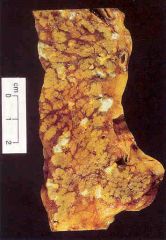
What is this pancreatic disease?
Gross - fat necrosis - hemorrhage Symptoms - "acute abdomen" |

acute pancreatitis
|
|
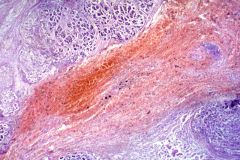
What is this pancreatic disease?
- acini degeneration - viable exocrine acini with edema - necrosis - hemorrhagic necrosis |
acute pancreatitis
|
|
|
What is the most common cause of acute pancreatitis in men?
|
alcoholism
|
|
|
What is the most common cause of acure pancreatitis in women?
|
calculi in common bile duct
|
|
|
How to manage acute pancreatitis?
|
- NPO (nothing by mouth): put pancreas at rest
- replace intravascular volume: prevent shock, maintain renal perfusion - support vital organ functions (heart, lung, kidneys): manage hypocalcemia (ca deposit in fat necrosis), nutrient by vein |
|
|
What is this pancreatic disease?
- repeated bouts of abdominal pain and pancreatic inflammation, leading to replacement of pancreatic parenchyma by fibrosis and chronic inflammation with variable degrees of exocrine insufficiency |
chronic pancreatitis
|
|
|
Pathogenesis of chronic pancreatitis.
|
acute pancreatitis -> recurrent acute episodes -> chronic pancreatitis
|
|
|
What is this pancreatic disease?
- malabsorption of fat - edema - DM - calcifications in pancreas - intermittent or persistent mild pain |
chronic pancreatitis
- exocrine insufficiency: fat malabsorption, protein malabsorption -> hypoalbuminemia -> edema |
|
|
Why do you see calcifications in chronic pancreatitis?
|
- decreased secretion of lithostathine which inhibits intraluminal precipitation of calcium salts
|
|
|
Important factors in pathogenesis of chronic pancreatitis. (4)
|
- ductal obstruction by concretion
- decreased secretion of lithostathine - ethanol induced oxidative stress (acinar cells) - intersitial fibrosis after inflammation/necrosis |
|

What is this pancreatic disease?
|

chronic panceatitis
- fibrosis, dilated ducts, calcifications |
|

What is this pancreatic disease?
- preserved islets - few prederved acinar - dilated pancreatic duct with proteinaceous concretions |
chronci pancreatitis
|
|
|
Sequalae of chronic pancreatitis.
|
- pseudocysts
- duct obstruction - malabsorption, steatorrhea - secondary diabetes |
|
|
T/F: All pancreatic cysts are potentially neoplastic.
|
T.
|
|
|
What are some congenital pancreatic cysts? are they common?
|
rare
- simple cysts - enterogenic - polycystic conditions |
|
|
What is the most common acquired pancreatic cyst?
|
pseudocyst
|
|
|
What are some acquired pancreatic cysts? are they common?
|
much more common than congenital
- pseudocysts - lymphoepithelial cysts - endometriotic cyst (usually in tail) - multicystic pancreatic hamartoma |
|
|
What is this pancreatic disease?
- unilocular, squamous lining, benign lymphoid tissue in pancreatic wall |
lymphoepithelial cysts
|
|
|
What is this pancreatic disease?
- disorganized lobules of acini and ducts with admixed fat and fibrous tissue |
multicystic pancreatic hamartoma
|
|
|
What is this pancreatic disease?
- collection of fluid containing pancreatic secretions and necrotic debris enclosed by a wall of fibrous granulation tissue - no epithelial lining |
pseudocyst
|
|
|
What is this pancreatic disease?
- cyst develops 4-6 wks after acute pancreatitis - contain pancreatic secretions and necrotic debris - wall of fibrous tissue, no epithelium |
pseudocyst
|
|
|
What are some complications of pancreatic pseudocyst?
|
- pain
- perforation - hemorrhage |
|
|
What is this pancreatic disease?
- cyst develops 4-6 wks after acute pancreatitis - contain pus - wall of fibrous tissue, no epithelium |
pancreatic abscess
|
|
|
Pancreatic pseudocyst can be diagnosed by _____.
|
CT or endoscopic ultrasound
|
|
|
How to manage pancreatic pseudocyst?
|
- drainage
- distal pancreatectomy if tail is involved |
|
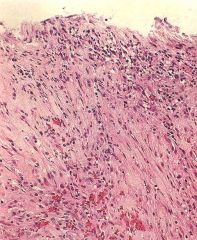
What is this pancreatic disease?
|

pseudocyst
- fibrosis and inflammation - no epithelium - preserved exocrine acini |
|
|
Name two benign neoplasm of pancreas.
|
- serous cystadenoma
- mucinous cystadenoma |
|
|
Name two benign neoplasm of pancreas.
|
- serous cystadenoma
- mucinous cystadenoma |
|

What is this pancreatic disease?
- cystic spaces lined by flattened uniform cells - contain watery fluid |
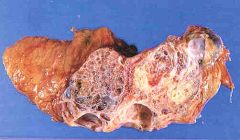
serous cystadenoma
|
|

What is this pancreatic disease?
- tall mucinous columnar cells lining cysts |
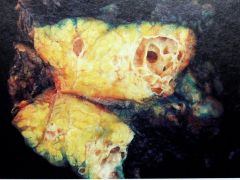
mucinous cystadenoma
|
|
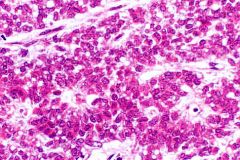
What is this pancreatic disease?
- in younger female - uniform cells in solid sheets or papillae - finely granular cytoplasm - gross: solid and cystic mass |

solid pseudopapillary neoplasm (borderline tumor)
- uncertain malignant potential - cured by excision |
|
|
Name some benign exocrine pancreatic neoplasms.
|
- serous cystadenoma
- mucinous cystadenoma- intraductal papillary mucinous adenoma - mature cystic teratoma |
|
|
Name some borderline exocrine pancreatic neoplasms.
|
- mucinous cystic neoplasm with dysplasia
- intraductal papillary mucinous adenoma with dysplasia - solid pseudopapillary neoplasm |
|
|
What is the 5th leading cause of death in US?
|
pancreatic carcinoma
|
|
|
What is the most likely cell origin of pancreatic carcinoma?
|
99% ductal cell
|
|
|
Risk factors for pancreatic carcinoma.
|
- smoking and chronic pancreatitis
- chronic alcohol abuse and DM |
|
|
What are some common genetic mutations involved in pancreatic ductal carcinoma?
|
- p-16 (>95%)
- K-ras (>90%) - p53 (60%) - SMAD4 (55%) |
|
|
What techniques are used to diagnose pancreatic carcinoma?
|
- imaging
- fine needle biopsy: needed to determine whether it is surgically treatable |
|
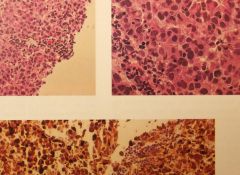
What is this pancreatic disease?
- fine needle biopsy: pleomorphic cells - positive for cytokeratin stain |
ductal carcinoma
|
|

What is this pancreatic disease?
- malaise, anorexia, wt loss, vague pain |
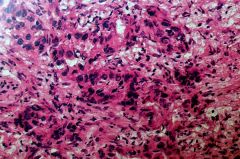
ductal adenocarcinoma
- irregular glands lined by pleomorphic cells with fibrous stroma |
|
|
What do you worry about when you see painless jaundice patients with wt loss?
|
pancreatic ductal carcinoma until proven otherwise
|
|
|
How to treat pancreatic ductal carcinoma < 2cm?
|
- whipple procedure
|
|
|
Which stage of pancreatic ductal carcinoma is surgically curable?
|
- only stage I
|
|
|
Prognosis for pancreatic ductal carcinoma.
|
BAD! 2-4% 5 yr survival
|
|
|
What is the most common islet cell tumor?
|
insulinoma
|
|
|
What is the most common islet cell tumor?
|
insulinoma
|
|

What is this pancreatic disease?
- tumor of pancreatic gastrin producing tumor - Z-E syndrome |
gastrinoma
- intractable severe and recurrent ulcers in stomach and duodenum |
|
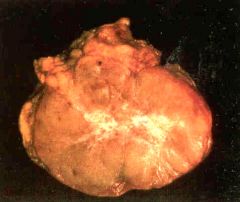
What is this pancreatic disease?
- hypoglycemia episodes |

insulinoma
- micro: ribbons/nested pattern |
|
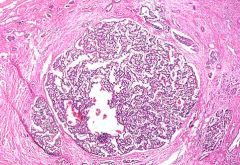
What is this pancreatic disease?
- hypoglycemia episodes |

insulinoma
- ribbons/nested pattern - IHC stain positive for insulin |
|

What is this pancreatic disease?
- IHC positive for chromogranin (left) and gastrin (right) |
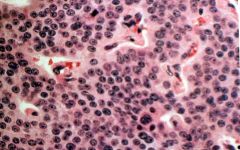
gastrinoma
- small uniform cells forming solid nests with prominent supporting capillaries |
|
|
How do normal islet cells look like?
|
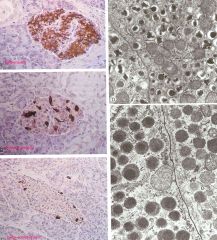
|

